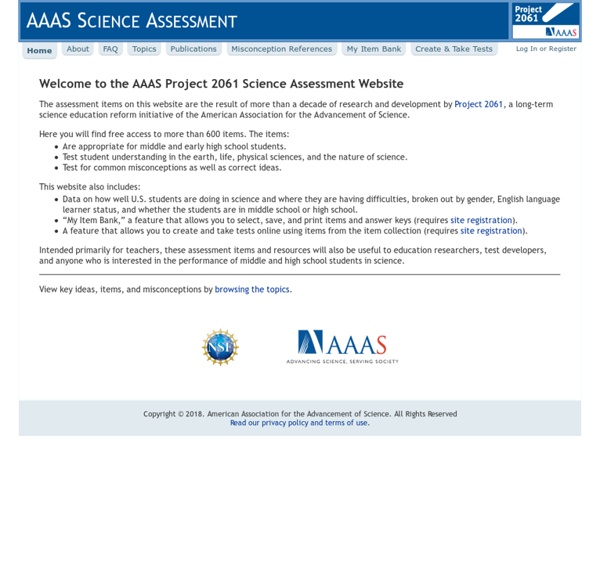



Q4B Concept Inventories | Questions For Biology Listed below are the Concept Inventories that are being developed by various members of the Q4B team. For information regarding specific inventories, click on the links to read the rationale behind development, how many questions have been – or will be – developed, the anticipated development timeframe until the inventory is ready for use, and any other inventory-specific information such as important teaching notes/guides. We encourage interested instructors from tertiary institutions to get in touch with team members to obtain concept inventories for use in their classes; in all cases, we ask instructors to send messages to the individuals who have worked on the inventories in which they are interested. Validated Concept Inventories (for which complete packages can be provided) 1: Biological Experimental Design Concept Inventory (BEDCI) 2: Meiosis 3: Population Dynamics 4: Speciation 5: Statistical Reasoning in Biology Concept Inventory (SRBCI) 6: Transcription and Translation 1: Adaptation
27 Science Fictions That Became Science Facts In 2012 We may never have our flying cars, but the future is here. From creating fully functioning artificial leaves to hacking the human brain, science made a lot of breakthroughs this year. 1. At the University of Pittsburgh, the neurobiology department worked with 52-year-old Jan Scheuermann over the course of 13 weeks to create a robotic arm controlled only by the power of Scheuermann’s mind. 2. Once the robot figures out how to do that without all the wires, humanity is doomed. 3. Photo Courtesy of Indigo Moon Yarns. At the University of Wyoming, scientists modified a group of silkworms to produce silk that is, weight for weight, stronger than steel. 4. Using an electron microscope, Enzo di Fabrizio and his team at the Italian Institute of Technology in Genoa snapped the first photos of the famous double helix.Source: newscientist.com / via: davi296 5. 6. ReCell by Avita Medical is a medical breakthrough for severe-burn victims. 7. 8. 9. 3-D Printer Creates Full-Size Houses in One Session
Assessment Instrument Information Page Assessment Instrument Information Page Please do not allow students to keep copies of any of these tests. It takes years of development effort to create and validate a reliable assessment instrument. If it is released to the public domain, students will locate it and all that work will be for naught. In fact, you might not want to use the formal name of the test on the versions you have students take. None of these tests are to be incorporated into a web-based question delivery system without adequate security to prevent printing or other unauthorized access by students. If you have any questions, please contact phone 919-515-7226 or e-mail Robert J. Graphing, Measurement TUG-K Beichner's Test of Understanding Graphs in Kinematics is available in English, Spanish, French, German, Finnish, and Portugese by sending e-mail to beichner@ncsu.edu . For graphing also see the FMCE, below. Deardorff & Beichner's Test of Measurement Uncertainty Concepts can be requested from beichner@ncsu.edu .
Pocket Heart on the App Store Free Online Course Materials | Courses el_198405_bloom.pdf Interactives archive: Biology Anatomy of ChildbirthReview the three stages of having a baby as well as some of the risks women face. Anatomy of the CoelacanthThis survivor from the age of dinosaurs has body parts found in no other living creature. Anatomy of a CrocExamine a Nile crocodile and see what makes this amazing reptile tick. Anatomy of a HiveInvestigate the physical, behavioral, and social infrastructure inside a bees' nest. Anatomy of Photo 51When you know how to look at it, this shadowy X-ray photograph speaks volumes about the shape of DNA. Bacteria TalkIn this interview, Bassler describes the 600 species of bacteria on your teeth each morning, and much more. Brain GeographyLearn how to model a brain and find out more about the cerebellum, spinal cord, brain stem, and cerebral cortex. Build a SteroidFollow the steps a chemist takes to synthesize a disease-fighting drug. Classifying LifeWhat do a polar bear and a sea cucumber have in common? Coelacanth QuizDoes this fish lay eggs? Guess What's Coming to Dinner?
10 Biggest High School Football Stadiums In Texas High school football is in the blood of Texas and as they say, everything is bigger in Texas, including our stadiums. 10. Stallworth Stadium – Baytown, TX – 16,500 capacity With a seating capacity of 16,500 Stallworth stadium comes in as the 10th largest high school football stadium in Texas. Goose Creek, Robert E. 9. Just around the corner from Baytown is the next stadium on our list; Pasadena’s Veteran’s Memorial Stadium. easygradepro - Home Page